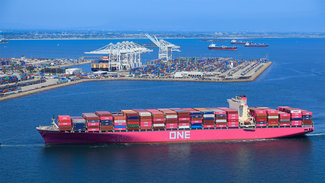SAN PEDRO, Calif. – The Port of Los Angeles moved 544,037 Twenty-Foot Equivalent Units (TEUs) in February, a 22.9% decrease compared to last year.
“While cargo volumes are important, the coronavirus is first and foremost a public health crisis that needs to be brought under control with the collaboration of governments and medical experts from around the world,” said Port of Los Angeles Executive Director Gene Seroka. “We are more interconnected than ever with our global partners so it’s no surprise that Trans-Pacific maritime trade has been significantly impacted.”
“As factory production in China remains at low levels, we expect soft volumes in March. Looking ahead to anticipated manufacturing improvements, we will need to return empty containers to Asia and push lingering U.S. export boxes out swiftly,” Seroka added. “We’re actively working with our supply chain partners to be prepared for a cargo surge once production levels ramp up.”
February imports decreased 22.5% to 270,025 TEUs compared to the previous year. Exports decreased 5.7% to 134,468 TEUs. Empty containers declined 35% to 139,544 TEUs. In total, February volumes, also adversely impacted by the Lunar New Year holiday celebrated in Asia, totaled 544,037 TEUs. For the first two months of 2020, total container volumes are 1,350,181 TEUs, down 13% compared to last year.
The Port of Los Angeles is America’s premier port and has a strong commitment to developing innovative, strategic and sustainable operations that benefit Southern California’s economy and quality of life. North America’s leading seaport by container volume and cargo value, the Port of Los Angeles facilitated $276 billion in trade during 2019. San Pedro Bay port complex operations and commerce facilitate one in nine jobs in the five-county Southern California region.
February cargo volume at the Port of Long Beach declined as well due to fewer ship calls amid the coronavirus outbreak and lingering effects of the trade dispute with China.
Terminal operators and dockworkers moved 538,428 TEUs last month, down 9.8% compared to February 2019. Imports dropped 17.9% to 248,592 TEUs, while exports increased 19.3% to 125,559 TEUs. Empty containers sent overseas decreased by 12.8% to 164,277 TEUs.
Although a Phase 1 preliminary trade agreement was signed in January by the United States and China, about USD 370 billion in Chinese goods remain under the increased tariffs, the port authority said.
“With the extended factory closures and slowdown of goods movement in China and other Asian countries in February due to Lunar New Year and COVID-19, we are seeing shipping lines needing to cancel some sailings,” said Mario Cordero, Executive Director of the Port of Long Beach.
“Once the virus is contained, we may see a surge of cargo, and our terminals, labor and supply chain will be ready to handle it.”
“Along with the economic effects of reduced trade due to the health situation, we also have the first confirmed cases of COVID-19 in Long Beach. We hope for the swift recovery of these individuals,” said Long Beach Harbor Commission President Bonnie Lowenthal.
“The port will continue to monitor the outbreak internationally, and work with our stakeholders to keep our crucial link in the supply chain open and operating.”





